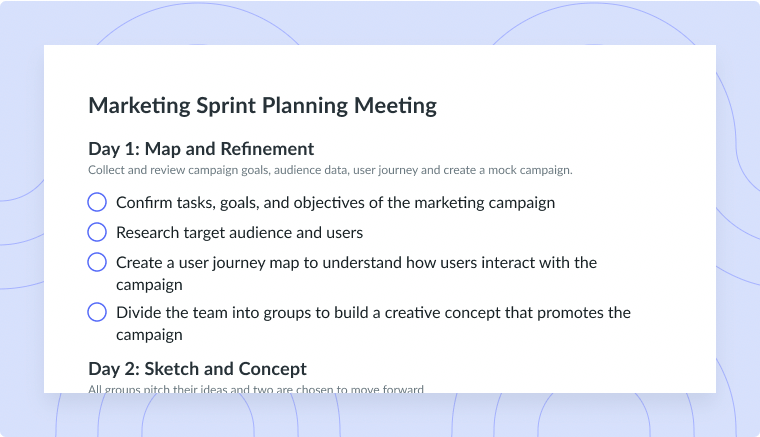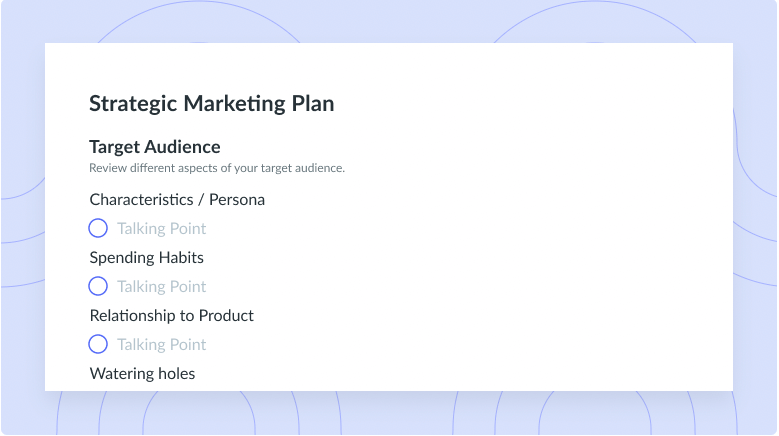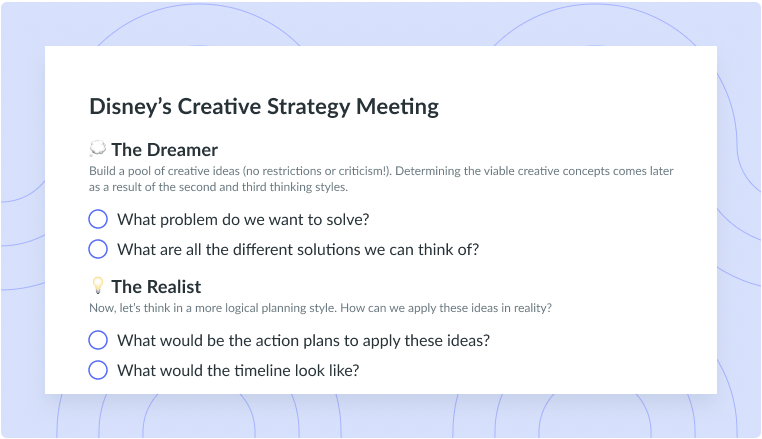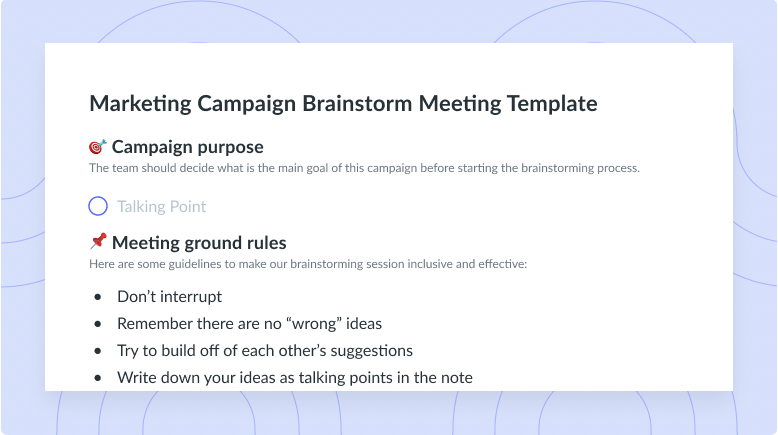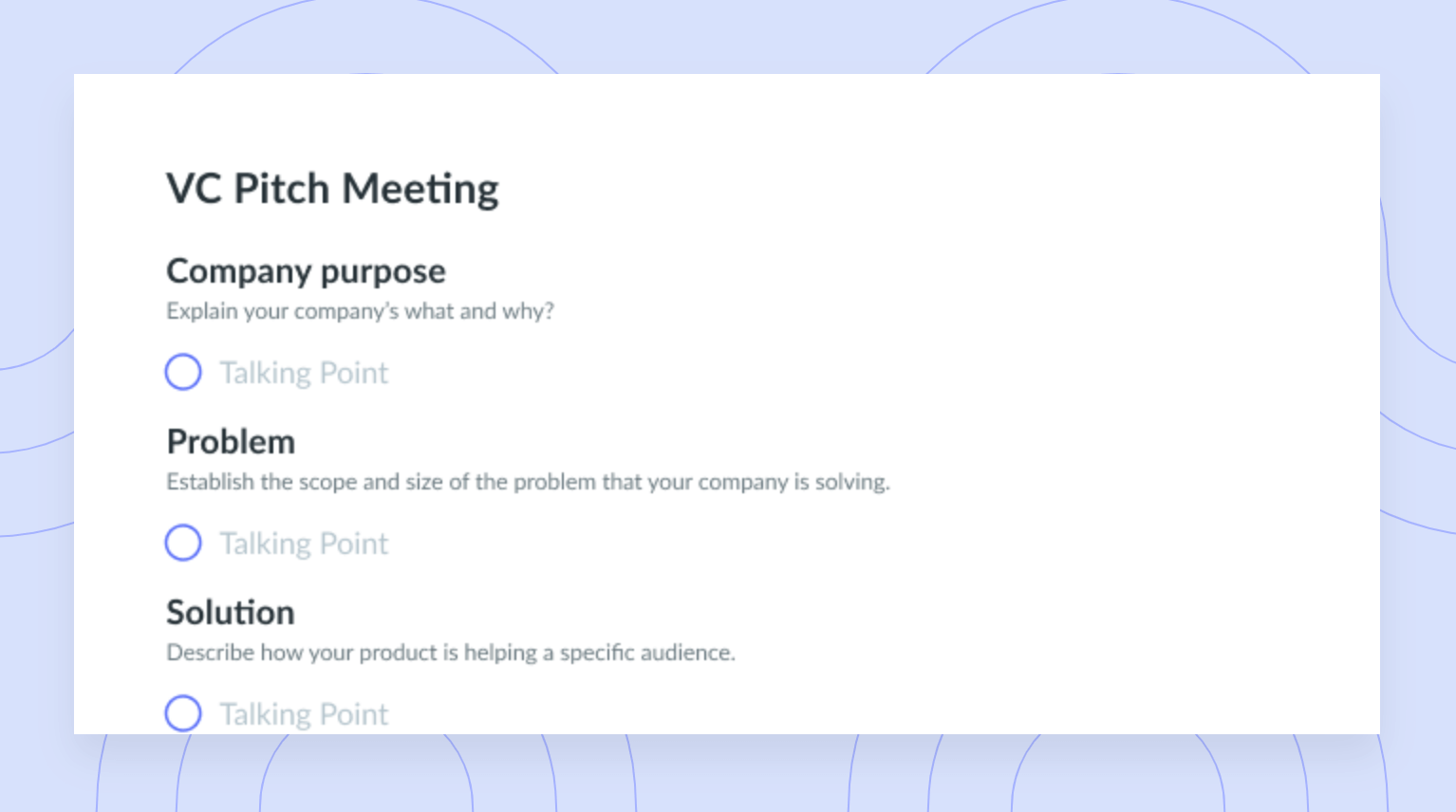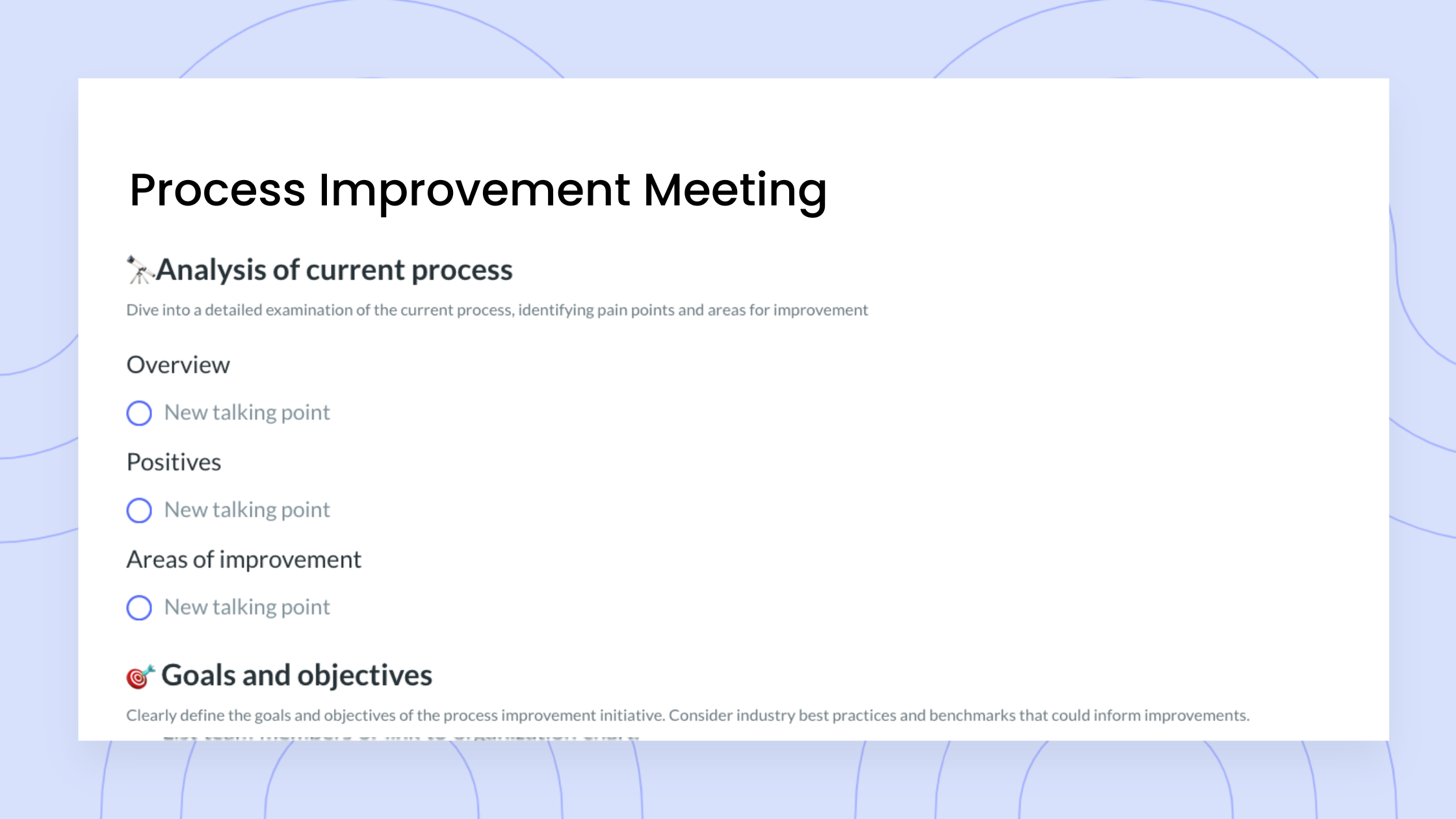Idea Generation: Definition and 8 Techniques
Ready for a lightbulb moment? Check out these 8 idea generation techniques your team can use to come up with the next big thing.
The next big idea is out there.
And your team may be moments away from its next big “light bulb” idea.
Idea generation is an important part of all types of companies, and all teams can take part in developing a new idea, concept, or strategy. You just need to know where to start and which technique to use to foster the best ideas in your team!
- What is idea generation?
- Why is idea generation important?
- Success factors for generating innovative business ideas
- 8 idea generation techniques
- How to put an idea into production
- How to test your idea
- Connecting the dots with Fellow
What is idea generation?
Idea generation is the act of coming up with new ideas. As part of the initial stage of the idea management funnel, idea generation encompasses generating answers to real challenges and brainstorming ways to solve problems. This process should lead to creative solutions for issues and opportunities as they arise. Working as a team or with coworkers and sharing ideas can help you generate more diverse and interesting concepts.
Think of idea generation as the spark that ignites creativity and innovation, making it essential for organizations across industries.

Foster collaboration and idea generation
Make meetings collaborative and productive with AI-enabled meeting preparation tools that provide context, structure, and accountability, and set the stage for great ideas to develop.
Why is idea generation important?
Coming up with innovative new ideas is an important part of any business. For many reasons, teams may want to use idea management tools or schedule brainstorming meetings. Below are four reasons idea generation is crucial.
- Discover fresh opportunities: Idea generation helps teams develop hidden potential and unexplored avenues. This can lead to new possibilities when solving problems.
- Formulate innovative concepts: By enhancing creativity and challenging basic assumptions, idea generation can pave the way for groundbreaking solutions.
- Finetune existing ideas: Through idea generation, teams can refine, enhance, and improve upon existing concepts, leading to improved efficiency and effectiveness.
- Revise current methodologies: By questioning the status quo and exploring alternative approaches, idea generation allows teams to update and improve upon established methods, keeping up with the organization’s evolving needs.
Success factors for generating innovative business ideas
There are some factors to consider if you want the practice of generating new ideas for your business to be successful.
What you’re solving
Before reaching a solution or conclusion, you and your team must understand the challenge or what you’re trying to solve. You may need to do some research, speak with clients and customers, or analyze trends. Having this knowledge is a must and can help get the ball rolling.
Audience and stakeholders’ needs
The ability to effectively develop creative new ideas stems from understanding the audience and what they need or care about most. This makes the end result—the new idea—feel unique, personal, and powerful.
Workplace culture
No matter what type of company culture your business has adopted, it should allow employees to creatively express themselves and have active discussions on various topics. Great idea generation is often stifled if employees don’t feel safe enough to express their thoughts.
8 idea generation techniques
There are many idea generation techniques that teams can try out. We break down eight of the most common techniques below.
- Reverse brainstorming
- Forced relationships
- Role-storming
- Storyboarding
- Five whys
- Six thinking hats
- S.C.A.M.P.E.R.
- S.W.O.T. analysis
1Reverse brainstorming
While teams are likely familiar with the concept of brainstorming to come up with a solution to a problem, reverse brainstorming starts with thinking about the causes of a problem. Starting on the causes can help teams proactively resolve or prevent the cause of the problem from happening again. This technique is often used to improve products or services.
If you’re unsure how to have a successful brainstorming session, try having a brainstorming meeting for your next big idea! With Fellow, you can conduct engaged, focused brainstorming meetings with collaborative and AI-enabled agendas to ensure you are fostering collaboration and accountability.
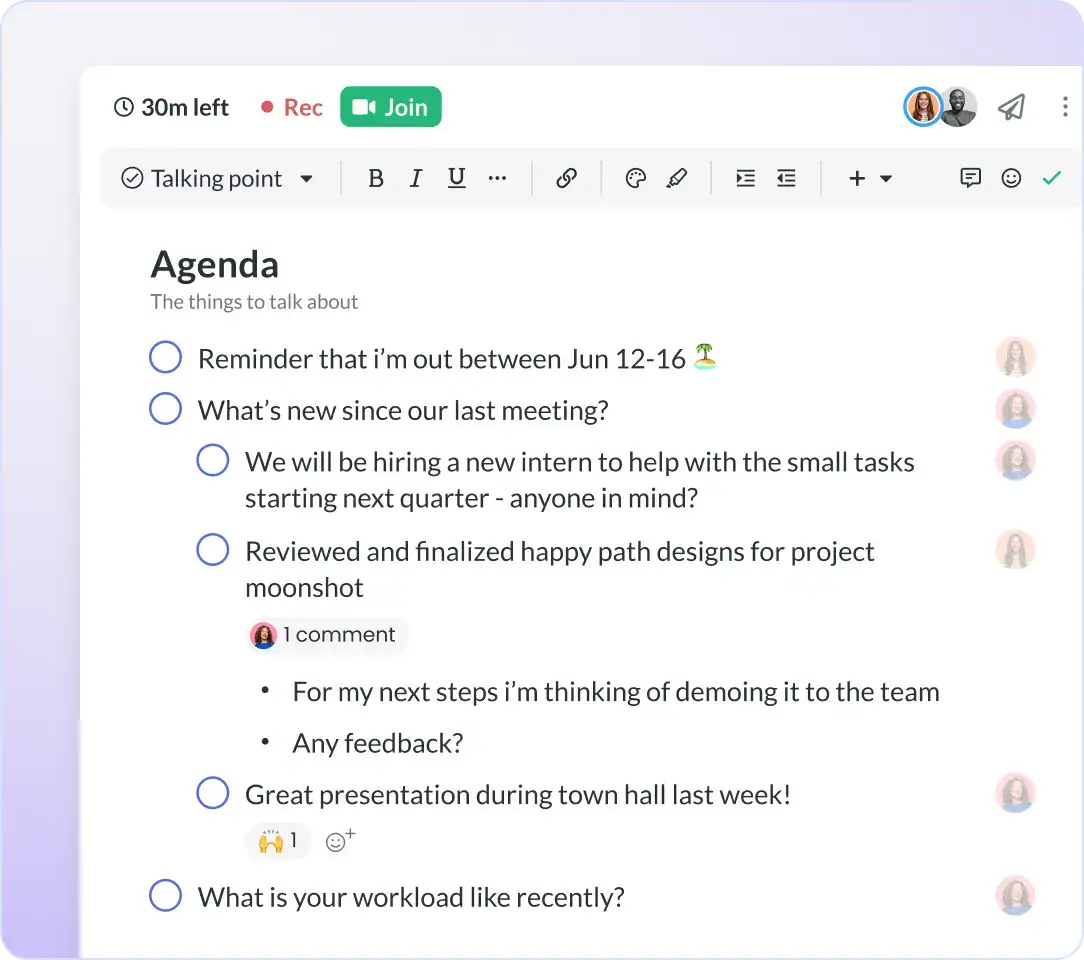
2Forced relationships
This technique is when two random, seemingly unrelated items are introduced, and those involved are meant to create a connection between them. This method of idea generation encourages innovative thinking as a strategy to build relationships and potentially develop a new product or service.
3Role-storming
Role-storming is an idea generation process where brainstorming and role-playing come together to create new ideas. Participants using this technique could imagine they’re in a different role in the organization or pretend they’re clients or even managers on a different team. While they’re in this different role, employees should ask themselves what improvements they’d implement or what changes they’d make.
4Storyboarding
Storyboarding is a concept where team members create a storyboard by finding visual information, quotes, or pictures and arranging them to create a specific narrative. Notes should be added along the way to explain the progression of the ideas as they take place.
Storyboarding can be an effective idea generation strategy, sometimes done in a sprint planning meeting, because of the physical aspect of seeking out items to add to the board. Having visual information in front of you can help inspire new ideas.
5Five whys
The five whys method starts with the team discussing a real or hypothetical problem they must solve together. First, ask the group why a problem happens or is taking place. After the first round of responses, the group leader asks why repeatedly until the fifth time.
The purpose of asking why five times is to find a deeper answer, as the first answer often doesn’t help solve the problem.
6Six thinking hats
Use the six ‘thinking hats’ method with a group of at least six people. Each group member represents a different thinking hat—or thought—that focuses on one of these six elements:
- Emotions
- Benefits
- Facts
- Judgment
- Ideas
- Planning
From there, participants essentially role-play with these specific hats as their core way of thinking. Each person or group must tackle the topic or problem from their assigned standpoint. This method promotes structured and balanced thinking from various viewpoints.
7S.C.A.M.P.E.R.
S.C.A.M.P.E.R. stands for:
- Substitute
- Combine
- Adapt
- Modify
- Put to another use
- Eliminate
- Reverse
This acronym acts as a question checklist to prompt ideas from the group. Team members need to consider various factors when solving a problem or coming up with a new idea, like substituting variables or combining one with another.
Doing so can help groups think critically and creatively to see things differently.
8S.W.O.T. analysis
S.W.O.T is an acronym that stands for:
- Strengths
- Weaknesses
- Opportunities
- Threats
This idea generation method can be used when working through projects and determining if they should continue down the pipeline. Teams can do this effectively with a SWOT analysis meeting agenda template that can ensure all important elements are brought up in the discussion.
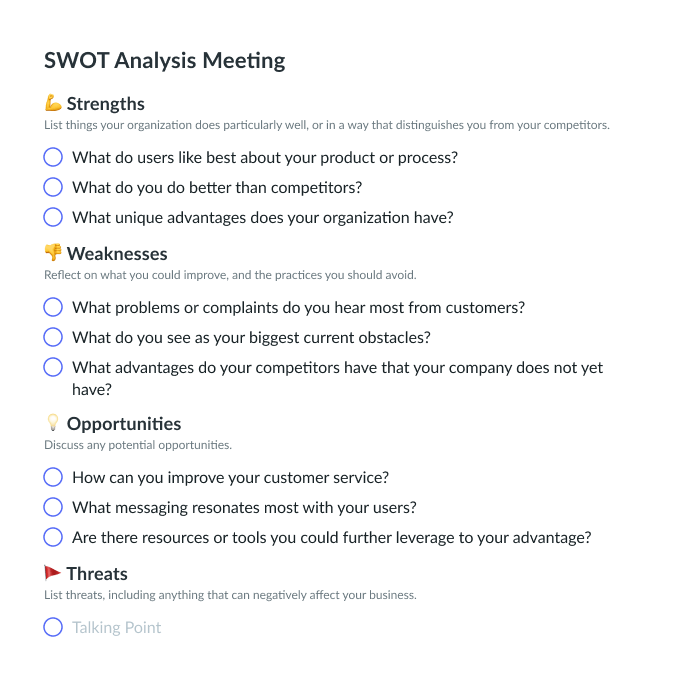
How to put an idea into production
Ready to put your idea into production? Follow these five steps to ensure nothing falls through the cracks.
- Develop your concept
- Conduct patent research
- Research your idea’s market
- Design a model of the product
- Build and test a prototype
1Develop your concept
Idea development starts with refining a concept. Team members should come up with an overview of the idea, design a potential mockup, or draft up a loose roadmap to bring the concept to fruition.
2Conduct patent research
Next is the research phase, during which you aim to determine whether someone else has already created a similar idea and has a patent. Suppose a similar idea has already been patented. In that case, certain elements of your idea should be adjusted or altered to target a different industry or group of people.
3Research your idea’s market
Once the team has conducted patent research, the target market must also be researched to see if anyone has expressed a need, want, or desire for your new idea. This can be done on social media, by speaking with clients and customers, or even by attending conferences or trade shows within your industry.
4Design a model of the product
The next step in bringing your idea to life is to design a model or mockup. This can be done by physically drawing the new product or using 3D modeling or 3D rendering software.
5Build and test a prototype
Finally, it’s time to build and test your prototype. Doing so will help your team know if any adjustments need to be made to the design and verify that your new product works and solves a specific challenge. This step can also test the materials it’s made of and make any last-minute improvements before testing on customers.
How to test your idea
Teams should consider these three ways to test out a new idea to achieve success.
Focus groups
Focus groups allow you to test an idea and gather relevant feedback from your target audience before it’s officially released. Iron out your goals ahead of time, find roughly 8-10 group members, and determine specific questions to which the team would like answers.
A/B testing
There’s also A/B testing, which is when two versions of a product are tested to see which one performs better or is liked more by potential buyers. Once data is collected about the performance of each product, the team can go with the idea that performed best or choose to combine what worked best in both.
Soft launch
Before your new product or idea is launched to the entire world, consider a soft launch. A soft launch is a rehearsal for a smaller or predetermined group of people. This is also a great way to collect data and fix any issues before introducing the idea to a wider audience.
You can track how your soft launch is performing with Fellow’s objectives and key results tool, and empower your team to easily review progress, resolve challenges, and keep all OKRs on track.
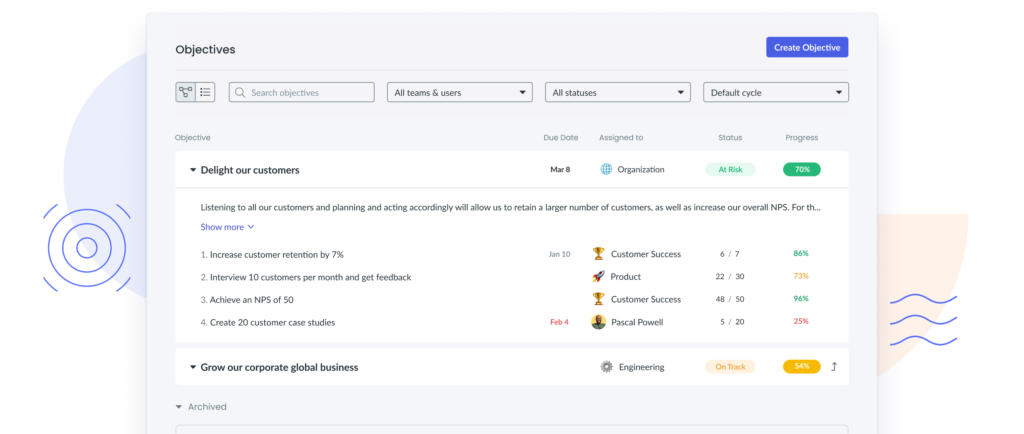
Connecting the dots with Fellow
As your team works to develop the next big thing, an all-in-one software like Fellow can support. As your team meets to cross every T and dot every I, Fellow’s AI Copilot will be there to automatically transcribe, record, and summarize every meeting so that every detail is accounted for. After the meeting, Fellow’s action items feature lets everyone know which task they’re responsible for completing. Get started with Fellow for free today!










